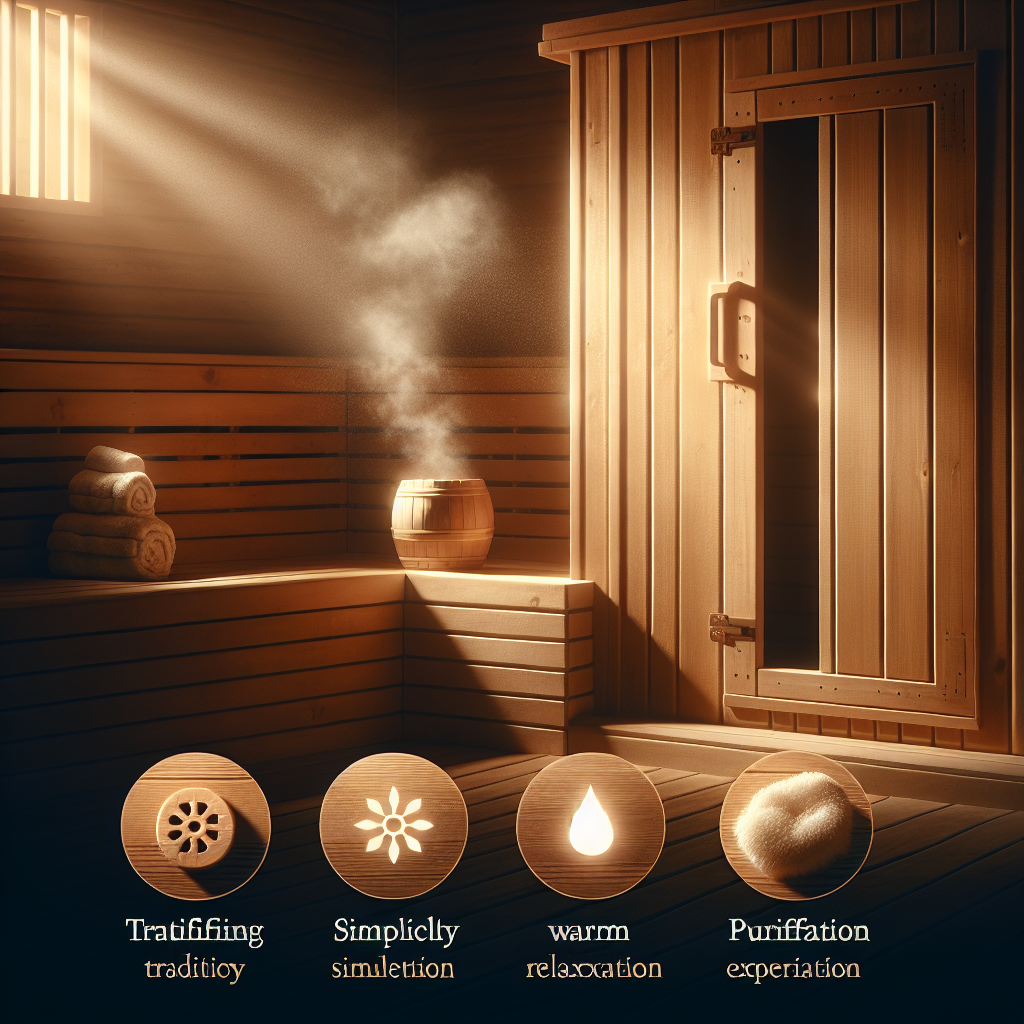Step into the world of traditional saunas and discover the potential benefits they hold for detoxifying your body. Many have long believed in the power of saunas to cleanse the body of toxins, and in this article, we will explore the evidence behind this ancient practice. Uncover the science, learn about the effects of heat on the body, and unveil the potential detoxification abilities of traditional saunas. Take a moment to relax, sit back, and immerse yourself in the warmth and purifying experience of traditional saunas.

Understanding Traditional Saunas
What are traditional saunas?
Traditional saunas, also known as Finnish saunas, have been used for centuries as a means of relaxation and cleansing. These saunas typically consist of a small, enclosed room made of wood, with wooden benches and a stove or heater that heats rocks to produce steam.
How do traditional saunas work?
Traditional saunas work by heating the air inside the sauna room, which in turn warms your body. The high temperature in the sauna causes your body to sweat, and this sweating is believed to help rid the body of toxins. Additionally, the steam generated by pouring water on the heated rocks increases the humidity in the sauna, creating a more intense sweating experience.
History of traditional saunas
Saunas have a long history, dating back thousands of years. The Finnish people are credited with popularizing the traditional sauna as we know it today. For them, saunas have been an integral part of their culture and daily life for centuries. Saunas were initially used for bathing and as a place for women to give birth. Over time, the Finnish sauna evolved to become a sacred space for spiritual and physical cleansing. Today, traditional saunas can be found in many parts of the world, offering people a chance to experience the benefits of this ancient practice.
Detoxification and the Body
What is detoxification?
Detoxification is the process by which the body rids itself of harmful substances or toxins. These toxins can come from various sources, such as the food we eat, the air we breathe, or even the products we use on our skin. Detoxification is a natural and essential function of the body, carried out primarily by the liver and kidneys.
Importance of detoxification
Detoxification is crucial for maintaining optimal health and well-being. It helps in removing waste products, metabolizing drugs, and supporting various bodily functions. When the body’s detoxification pathways are functioning properly, it can help prevent the accumulation of toxins and reduce the risk of chronic diseases.
How does the body detoxify naturally?
The body has several built-in detoxification pathways that work together to eliminate toxins. The liver is the primary organ responsible for detoxification. It metabolizes toxins and converts them into less harmful substances that can be eliminated from the body. The kidneys filter waste products from the blood and excrete them in the form of urine. Other detoxification pathways include the respiratory system, digestive system, and lymphatic system, which all play a role in eliminating toxins from the body.
Claims of Sauna Detoxification
Saunas as a detoxification method
Saunas, including traditional saunas, have long been associated with detoxification. Advocates claim that the high temperatures and sweating induced by saunas can help eliminate toxins from the body. However, it is important to note that the primary role of saunas is to promote relaxation and provide a soothing experience, rather than being a direct detoxification method.
Specific claims about sauna detoxification
Supporters of sauna detoxification often make specific claims about its benefits. These claims include the elimination of heavy metals, such as lead and mercury, through sweating, as well as the removal of fat-soluble toxins from the body. However, it is essential to approach these claims with caution, as more research is needed to fully understand the extent of sauna’s detoxification capabilities.
Research and studies on sauna detoxification
While there is limited research specifically focused on sauna detoxification, studies have shown that sweating can help eliminate certain toxins from the body, such as BPA and phthalates. Sweating also increases blood circulation, which can support the body’s natural detoxification processes. However, more rigorous scientific studies are required to determine the full extent of saunas’ detoxification effects.
Heat and Sweating
The connection between heat and sweating
Heat plays a vital role in the sweating process, as it helps to regulate body temperature. When the body is exposed to high temperatures, such as in a sauna, the sweat glands are activated to produce sweat. Sweating is the body’s way of cooling down and maintaining a stable internal temperature.
Effects of heat on the body
The heat experienced in a sauna has various effects on the body. It dilates blood vessels, increasing blood flow to the skin’s surface, which helps to carry away heat. This process can enhance overall circulation and promote a sense of relaxation. The heat also stimulates the production of endorphins, which are natural painkillers and can contribute to a sense of well-being.
Benefits of sweating
Sweating offers several benefits beyond cooling the body. It helps to unclog pores, cleanse the skin, and remove excess oil and impurities. Sweating can also help eliminate toxins like urea and ammonia. Additionally, sweating can improve cardiovascular health, reduce stress, and support the immune system. These benefits make sweating a natural and valuable process for the body.

Detoxification Pathways
Liver’s role in detoxification
The liver is a vital organ when it comes to detoxification. It performs multiple functions, including breaking down toxins, metabolizing drugs, and filtering waste products from the blood. The liver detoxification process involves two phases: Phase I, where toxins are converted into intermediate metabolites, and Phase II, where these metabolites are further processed and made water-soluble for elimination from the body.
Kidneys’ role in detoxification
The kidneys play a crucial role in detoxification by filtering waste products, toxins, and excess fluid from the bloodstream. They create urine, which carries these waste products out of the body. The kidneys also help regulate electrolyte balance and maintain proper blood pressure.
Other detoxification pathways in the body
In addition to the liver and kidneys, the body has several other detoxification pathways. The respiratory system eliminates toxins through exhalation, while the digestive system removes waste through bowel movements. The lymphatic system, which consists of lymph nodes and vessels, helps filter toxins from the body’s tissues. These detoxification pathways work together to ensure the body remains free of harmful substances.
Sauna Effects on Detoxification
Heat’s impact on detoxification pathways
The heat in a sauna can have indirect effects on the body’s detoxification pathways. The increase in body temperature caused by saunas can lead to increased blood flow, which may support the efficient functioning of the liver and kidneys. Improved blood circulation can also assist in transporting toxins to the organs responsible for elimination.
Sweating and elimination of toxins
Sweating induced by saunas can facilitate the elimination of certain toxins from the body. Studies have shown that sweating can help remove heavy metals like lead, cadmium, and arsenic. Sweating may also contribute to the elimination of BPA, a chemical found in many plastics, and phthalates, which are often used in personal care products. However, more research is needed to fully understand the extent to which saunas aid in toxin elimination.
Can saunas enhance detoxification?
While saunas may offer some benefits in terms of supporting the body’s detoxification processes, it is important to approach them as part of a holistic approach to health. Saunas should not be relied upon as the sole method of detoxification. Instead, they should be complemented by a healthy lifestyle, including a balanced diet, regular exercise, and adequate hydration.
Additional Benefits of Saunas
Relaxation and stress reduction
One of the primary benefits of saunas is their ability to promote relaxation and reduce stress. The heat and steam create a soothing environment that can help calm the mind and body. Sauna sessions provide a space for people to unwind, relax their muscles, and enjoy a moment of tranquility.
Improved circulation
The heat in saunas dilates blood vessels and increases blood flow, resulting in improved circulation. This enhanced circulation can have various positive effects on the body, such as delivering oxygen and nutrients to tissues, promoting healing, and aiding in the removal of waste products.
Pain relief
Sauna use has been associated with the temporary relief of muscle and joint pain. The heat helps to relax muscles, reduce inflammation, and alleviate discomfort. Many people find relief from conditions like arthritis, sore muscles, and tension headaches after a sauna session.
Potential Risks and Precautions
Dehydration risk
Saunas cause sweating, which can lead to fluid loss and dehydration. It is crucial to drink plenty of water before, during, and after sauna sessions to maintain proper hydration levels. Individuals who are especially vulnerable to dehydration, such as the elderly or those with certain medical conditions, should exercise caution and consult a healthcare professional before using a sauna.
Heat-related illnesses
The high temperatures in saunas can pose a risk of heat-related illnesses, such as heat exhaustion or heat stroke. It is essential to listen to your body and recognize signs of overheating, such as dizziness, nausea, or fatigue. If you experience any of these symptoms, it is crucial to leave the sauna, cool down, and hydrate immediately.
Contraindications for sauna use
Saunas may not be suitable for everyone. Individuals with certain medical conditions, such as heart disease, high blood pressure, or respiratory disorders, should consult their healthcare provider before using a sauna. Pregnant women, individuals with open wounds, or those under the influence of alcohol or drugs should also avoid sauna use.
Tips for Sauna Use
Hydration before and during
To prevent dehydration, it is important to hydrate adequately before entering a sauna. Drink plenty of water or electrolyte-rich fluids to ensure your body is properly hydrated. It is also essential to drink water during your sauna session to replace any fluids lost through sweating.
Moderation and duration
Sauna sessions should be done in moderation to avoid overheating and potential risks. Start with shorter sessions, around 10-15 minutes, and gradually increase the duration as your body becomes acclimated. It is generally recommended to limit sauna sessions to 20-30 minutes to avoid potential negative effects.
Listening to your body
Pay attention to how your body is responding during a sauna session. If you feel lightheaded, dizzy, or uncomfortable, it is important to leave the sauna and cool down immediately. Everyone’s tolerance to heat varies, so it’s essential to listen to your body’s signals and adjust accordingly.
Conclusion
Traditional saunas have a long-standing history and are known for their relaxation benefits. While they are often associated with detoxification, it is important to view saunas as just one part of a holistic approach to health and well-being. Saunas can promote sweating and increase blood circulation, which may indirectly support the body’s detoxification processes. However, there is a need for more scientific research to fully understand the extent of saunas’ detoxification capabilities. It is essential to prioritize safety, hydration, and moderation when incorporating saunas into your wellness routine. As always, it is recommended to consult with a healthcare professional before starting any new health practice.

